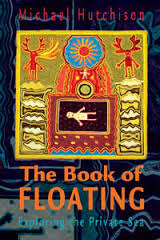When I was pregnant with my daughter Bethany, I knew straight away that I wanted a waterbirth. I so strongly resonated with the sea that I swam with dolphins off the coast in the far north of New Zealand.

Seconds after giving birth at home, by candlelight and Mozart, to my daughter Bethany.
I met with a woman who’d had five waterbirths, and she shared a book with me by Elaine Morgan, called The Descent of Woman. I immediately resonated with her theory of evolution which cites recent geological and anthropological evidence that large areas of Africa were flooded and covered by vast seas, with the exception that some upland areas were islands. Her theory is that one group of apes adapted to an aquatic environment, and when the water receded new ecological opportunities opened up. We lost our hair because it was better to keep warm in water by a layer of fat inside the skin than a layer of hair on the outside. It certainly helps to make sense of the reflex babies have which allows them to be born underwater.
We were made to float, it would seem: it’s in our genes.
I’ve always loved water. Warm water. Whether that is because of my connection to my mother’s gorgeous womb, or the ancestral memory of my foremothers, I don’t know. Maybe it’s both. When I float in the water, am I remembering them “bobbing blissfully” and hearing the surf in their ears? Could that shallow salt sea of five million years ago still be so readily heard? I’m certainly open to the possibility.
When I bumped into a friend last week, I had no idea that she’d taken over a local complementary therapy centre. I was really interested to hear about the floatation tank. It sounded peaceful. Paul and I jumped at the chance to have a float.
What I didn’t realise was what a valuable tool it is for health and well-being on so many levels.
I’ve just finished reading The Floating Book: Exploring the Private Seas, by Michael Hutchinson. I can’t recommend it highly enough. I love it when I can match intuition with science.
I wish I’d known about these studies, and had the experience of floating behind me, when I wrote my book Natural Approaches to Healing Adrenal Fatigue. Floating is the perfect antidote (cure) for the rush of hormones which cause stress. An hour in the tank gave me more energy that afternoon than I’d had in ten years. The beautiful thing about floatation therapy is that the effect lasts much longer than your time in the pool. It can last days, and for some people, weeks.
Floating not only alters the set-point to help us lower adrenal activation, but also increases our tolerance for stress. It significantly decreases blood pressure, heart rate, oxygen consumption, blood lactate and muscular tension.
If you suffer adrenal fatigue, it’s worth knowing that floating decreases levels of fight or flight chemicals such as epinephrine, norepinephrine, ACTH, and cortisol. Floating counteracts the fight or flight response. That’s just from one float. And the beauty of it is that is has a maintenance effect, lasting many days after. Studies show that it alters the metabolism (or homeostatic set points). It enhances our relaxation response.
Not only is floating great for easing pain or injuries, and bringing relaxation to our bodies, it has been proven an ideal way to enhance visualisation, due to the effect on the brain waves. Studies show it is an invaluable tool to learning, too. When we float, we are in the ‘zone’, a place of pleasure that allows us to literally go with the flow. Many people have experienced enhanced creativity, inspiration, life-changing insights, and gratitude for life by floating.
I look forward to making floating a regular part of my life, and giving my whole being the nourishment it desperately needs.
If you’re in Cumbria, why not have a floatation session at http://www.calicohealthandwellbeingcentre.co.uk or look up one local to where you live.





